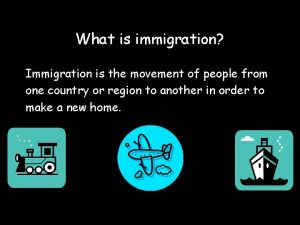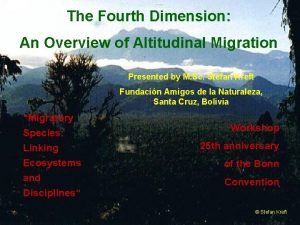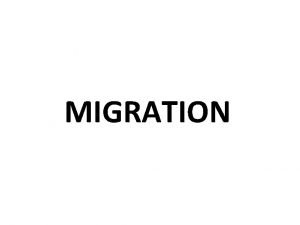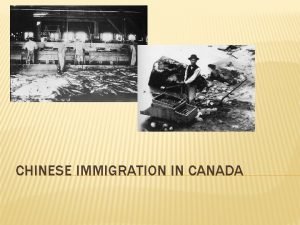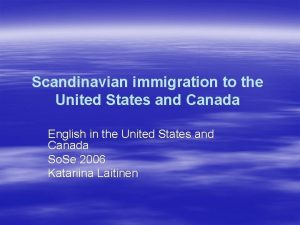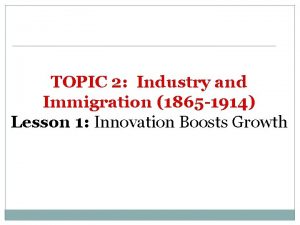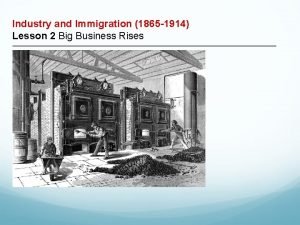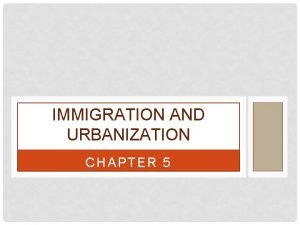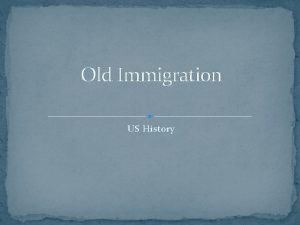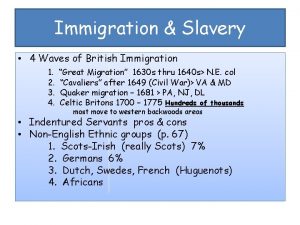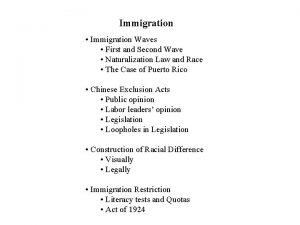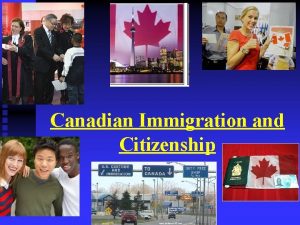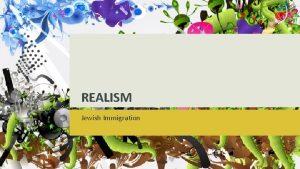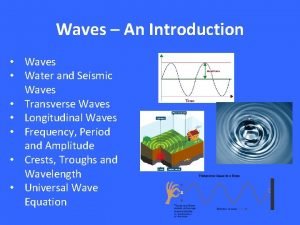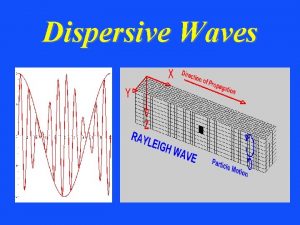A HISTORY OF U S IMMIGRATION IMMIGRATION WAVES






































- Slides: 38

A HISTORY OF U. S. IMMIGRATION

IMMIGRATION WAVES Immigration waves were periods or “waves” of time that experienced large and enduring increases in immigration to the United States.

WHY ARE THESE WAVES SO IMPORTANT? With each immigration wave that the United States has experienced, the culture and context of life in the United States have changed considerably. Such changes have continued into the twenty-first century.

QUESTIONS TO CONSIDER v v v v Where did the immigrants come from? When did they arrive? Why did they leave their home countries? Why did they choose the U. S. ? Where did they settle? What types of jobs did they have? What aspects of their culture did they bring? What impact did immigrant cultural traditions have on the United States?

MAIN REASONS FOR IMMIGRATION There are two types of motivation for immigration. 1) PUSH factors (reasons to leave home country) 2) PULL factors (reasons for settling in USA)

U. S. IMMIGRATION PUSH FACTORS v Change in Economy/Lack of Jobs v Lack of Political Freedom in Homeland v Religious Intolerance in Homeland v Political Refugees/Fear for Their Lives v War/Violence Back Home v Lack of or Inadequate Education v Starvation/Lack of Options v Forced Immigration (Slavery)

U. S. IMMIGRATION PULL FACTORS v Land is plentiful and fairly cheap. v Land of opportunity! v Jobs are abundant and wages are high (comparitively) v Industry and Urbanization v Notion that in America, the streets were "paved with gold! v Religious Freedom/Tolerance v Political Freedom/Tolerance v Educational Opportunities v Less Poverty/Abundance of Food

FOUR WAVES OF U. S. IMMIGRATION First Modern Wave of Immigration, 1609 -1775 Second Wave of U. S. Immigration, 1820 -1870 Third Wave of U. S. Immigration, 1880 -1920 Fourth Wave of U. S. Immigration, 1965 Present Day

THE FIRST MODERN WAVE OF IMMIGRATION ~ First Wave of U. S. Immigration occurred between 1609 and 1775 ~ Why? Quests for adventure, flights from religious persecution, and hopes for brighter economic futures. ~ Approximately 500, 000 Europeans left their homeland came to America. ~ Many of these new arrivals were indentured servants, under contract to work for masters from four to seven years merely to pay the costs of their transatlantic passage. ~The first black Africans who came to America during this period also came as indentured servants. However, almost all the Africans who followed came as slaves.

THE FIRST MODERN WAVE OF IMMIGRATION ~Most immigrants who came during the seventeenth century were from England, with smaller numbers from France, Germany, Ireland, Scotland, Italy, and other countries. ~ Between 1700 and the start of the American Revolution in 1775, the colonial population almost doubled, to 450, 000. ~During that period, the principal port of entry was Philadelphia, but immigrants also entered through Baltimore, Maryland, and Charleston, South Carolina.

THE FIRST WAVE OF U. S. IMMIGRATION Video Link from America’s Immigration History Colonists and Slaves Arrive to the New World http: //www. bing. com/videos/search? q=first +immigrants+to+us+colonial+america&&vi ew=detail&mid=065853263176 C 5 EB 67 EB&FORM=VRDG AR

THE SECOND WAVE OF U. S. IMMIGRATION ~ The Second Wave of U. S. Immigration occurred between 1820 and 1870. ~ After a lull in immigration during the American Revolution and wars in Europe, a second wave of immigrants began arriving around 1820. ~ Most of these newcomers entered the United States through New York City, instead of Philadelphia. ~ Castle Garden was opened at the southern tip of Manhattan Island in New York City as the nation’s first immigration station. ~ A majority of immigrants arriving on the East Coast during this second wave were Irish and Germans. A potato famine hit Ireland during the 1840’s, and as much as one-third of the immigrants during this time were Irish fleeing that famine.

THE SECOND WAVE OF U. S. IMMIGRATION ~ Gold was discovered in California in 1848, and the transcontinental railroad was begun in 1862. Both the lure of gold and the prospect of work on the railroad brought a wave of Chinese immigrants to the West Coast of the United States. ~ This migration of Chinese came to an end in 1882, after the U. S. Congress enacted the Chinese Exclusion Act that year. That law made immigration for practically all ethnic Chinese illegal. ~ Meanwhile, most Chinese immigrants entered the United States through the port of San Francisco. Most of them were single men who planned to make their fortunes and return to China. However, a large proportion of them ended up spending the rest of their lives in the United States, where most of them worked in low-paying jobs.

THE SECOND WAVE OF U. S. IMMIGRATION ~ In response to fears of native-born Americans about job competition, concerns about religious and political differences, and simple, blatant racism, a political party was formed called the America Party or the Know-Nothing Party. ~ During the 1850’s, supporters of this party and other nativist movements demanded laws that would reduce immigration, particularly from Asia. Also, the state of California, where most of the Chinese immigrants worked, enacted its own laws to discourage Chinese immigration. ~ During the 1870’s, the United States suffered an economic depression at the same time Germany and Great Britain were enjoying relative prosperity. The combination of restrictive legislation and economic problems caused immigration to go through another period of decline.

THE IRISH v Settled in New York (too poor to travel) v Discriminated against v Poor living conditions (80% of Irish infants died in New York) v Took the jobs that no one else wanted v "Let Negroes be servants, and if not Negroes, let Irishmen fill their place. . . « v With the arrival of Eastern Europeans the Irish were no longer the lowest class v Many became policemen & firemen

THE DIFFICULT TRANSITION FOR IRISH IMMIGRANTS

ANTI-CHINESE NATIVISM ~ There was a vast amount of anti-Chinese immigrant feelings in the USA ~ The Chinese FLOODED to the U. S. after 1850 s (100, 000) ~ The Chinese laborers were essential to American West especially in regards to industrialization and railroads ~ Once the industrial projects were completed the Chinese were NOT needed anymore ~ Nativist backlash against the Chinese was very common since: 1) They looked very different 2) Their language, customs, religion, and ideas were different 3) They were considered as extremely cheap labor ~ This led to the Chinese Exclusion Act (1884 -1943), which was the first immigration law to ban a certain race of people from coming to America

THE SECOND WAVE OF U. S. IMMIGRATION Video Link from Gangs of New York Irish Immigrants Arrive In New York https: //www. youtube. com/watch? v=ns-qtoxn. AS 8

THE THIRD WAVE OF U. S. IMMIGRATION ~ The Third Wave of U. S. Immigration occurred between 1880 and 1920. ~ During the 1880’s, American states seeking to increase their populations and railroad companies seeking laborers began sending agents across the Atlantic to recruit immigrant workers. ~ By the late nineteenth century, transoceanic transportation had become significantly cheaper and less arduous, making it easier for poor Europeans to immigrate to the United States. ~ The period between 1880 and 1920 brought more than 23 million new immigrants from all parts of the world, but mostly from Europe, to the United States.

THE THIRD WAVE OF U. S. IMMIGRATION ~ The first decade of this period saw most of the immigrants coming from northern and western Europe; after 1890, the majority came from southern and eastern Europe. Meanwhile, restrictive U. S. immigration laws continued to keep the numbers of immigrants from Asia very small. ~ Like the Chinese immigrants of the previous wave, many of the new immigrants from southern and eastern Europe encountered a good deal of hostility in their new homeland. Again feeling threatened by job competition, and concerned about racial, religious, and political differences, native-born Americans directed their new hostility primarily against Jewish immigrants, Roman Catholics, and Japanese.

THE THIRD WAVE OF U. S. IMMIGRATION ~ Before long, a general distrust and resentment of all new immigrants began to grow. Anti-immigrant sentiment found its way into federal government, and the U. S. Congress enacted a new series of restrictive immigration laws between 1917 and 1924. The Immigration Act of 1917, for example, required immigrants to demonstrate their ability to read and write. The same law also created the “Asiatic Barred Zone” to halt immigration from most of Asia. ~ Nevertheless, despite their chilly reception, immigrants continued to pour into the United States in search of better lives. ~ Immigration into the United States was further curtailed by the onset of the Great Depression of the 1930’s. During the Depression years, more people emigrated from the United States than immigrated.

REASONS FOR IMMIGRATION (1880 -1920) v. Jewish families came for religious freedom v. Italians and Asians came for work v. Russians came to escape persecution Why? v. The United States had jobs v. The U. S. had religious freedom v. America was hyped up in many countries as "Land of Opportunity"

EASTERN/SOUTHERN EUROPE IMMIGRANTS v Immigrants from Southeastern Europe blamed for increasing problems v 1880 – 1920 →New York grew by 300%, Chicago → 400%, L. A→ 1000% v These newcomers were often described by what they were not: • • • Not Protestant Not English-speaking Not skilled Not educated Not liked.

~ LIVING CONDITIONS IN AMERICA ~ v It Was Not Always the American Dream that was Expected by Immigrants v Filthy, dirty, diseases spread, cramped v Gambling, drinking, etc. v Ethnic Neighborhoods v “Ghetto” – Italian word for describing Jewish section… and being trapped in at night by an iron gate v Immigrants TRAPPED in to this lifestyle

TENEMENT HOUSING AND ETHNIC NEIGHBORHOODS v Tenement Housing: poor, rundown housing where many families lived in small, cramped conditions in the big cities v Ethnic Neighborhoods: • Helped embrace New World hardships • Continuation of OLD WORLD customs that weren’t as accepted in mainstream USA

ELLIS ISLAND ANGEL ISLAND Ellis Island, NY v 1892 – immigration station v 112 million immigrants would pass through Ellis Island v. Immigrants held for SICKNESS, tests of mental ability Angel Island, CA v. Chinese detained for weeks (Chinese Exclusion Act) • Prison-like conditions • Accused of being SICK more often than European immigrants

THE THIRD WAVE OF U. S. IMMIGRATION Video Link from The Godfather Part II Vito Corleone Arrives At Ellis Island from Italy https: //www. youtube. com/watch? v=ub. T-Bm 36 L 2 U

THE FOURTH WAVE OF U. S. IMMIGRATION ~The Fourth Wave of U. S. Immigration occurred after 1965 (to present day). . . ~ In 1965, passage of the federal Immigration and Nationality Act ended the system of quotas based on nationality. In their place was a new, far less restrictive quota system based on hemispheres. ~ The new system permitted 120, 000 immigrants per year from the Western Hemisphere and 170, 000 from the Eastern Hemisphere. ~ In 1978, even these quotas were replaced by a single, worldwide quota of 290, 000 immigrants per year from all parts of the world. From 1992 to 1994, this figure was raised to 700, 000 immigrants before being reduced to 675, 000 in 1995.

THE FOURTH WAVE OF U. S. IMMIGRATION ~ None of these quotas placed any limits on the numbers of immediate family members of U. S. citizens who could enter the country. As a consequence, the actual numbers of immigrants who entered the United States legally were much higher than the quota figures. ~ During the first decade of the twenty-first century, the United States was still in the midst of the largest wave of immigration in its history. One million immigrants entered the country legally every year. ~ By the first decade of the twenty-first century, fully one-tenth of all residents of the United States were foreign born. In addition to these approximately 30 million legal immigrants in the country, the U. S. Census estimated that about 8. 7 million immigrants were in the country illegally.

THE FOURTH WAVE OF U. S. IMMIGRATION ~ Most new immigrants, both legal and illegal, were Hispanics from Mexico, the Caribbean, and Central America. Between 1990 and 2000, the Hispanic population of the United States increased 63 percent—from 22. 4 million to 35. 3 million residents. ~ Indeed, the largest and longest-enduring movement of laborers between any two countries in the world has been from Mexico to the United States. ~ In more recent years there has been an increase in Asian, African, and Middle Eastern immigrants.

THE FOURTH WAVE OF U. S. IMMIGRATION Video Link from Mc. Farland USA Vito Corleone Arrives At Ellis Island from Italy https: //www. youtube. com/watch? v=KA 9 Iy 0 GFbs. I https: //www. youtube. com/watch? v=3_fzm. VSZZd. Q

CLASS DISCUSSION v “ A simple way to take measure of a country is to look at how many want in…. and how many want out…. . ” • Take measure of America today. Apply this to immigration trends today. Is this statement accurate? Why or why not? • Imagine you are all the head of an immigrant household. Would you still bring your family to America today? Why or why not?

FEELINGS OF NATIVISM COMMON IN THE LAND OF THE FREE! v Feeling of hatred towards those that were considered not “American” v Immigrant groups despised other immigrant groups v There always seemed to be another group to “pick on”

IMMIGRATION TERMINOLOGY MELTING POT VS SALAD BOWL v Melting Pot→ All immigrants mixed together to form the “American” society (assimilation) v Salad Bowl → All immigrants are American, yet respect and maintain their cultural heritage and traditions from their “original home”

THE FIRST MODERN WAVE OF IMMIGRATION v _________, and ____were the major reasons why the First Wave of U. S. Immigration occurred. v Approximately _____ Europeans left their homeland came to the United States during the First Wave. v The principal port of entry during the First Wave was in __________. v The First Modern Wave occurred from ______ to ______.

THE SECOND WAVE OF U. S. IMMIGRATION v Instead of ________, most immigrants in the Second Wave entered the U. S. through _______. v The majority of immigrants arriving on the East Coast during the Second Wave came from ______ and ______. v Both the prospect of work and the discovery of gold in California brought a wave of _______ immigrants to the West Coast. v The ___________ made immigration illegal for the majority of ethnic Chinese.

THE THIRD WAVE OF U. S. IMMIGRATION v Between 1880 and 1920, more than ________ new immigrants came to the U. S. . v The first decade (1880 s) of the Third Wave period saw most immigrants arrive from ______ and ______ Europe. After 1890, the majority of immigrants came from ________ and ________ Europe. v The Immigration Act of ______ required immigrants to demonstrate their ability to _______ and ______. The same law created the “Asiatic Barred Zone” to halt immigration from most of Asia. v During the Great Depression more people ________ from the United States than ________.

THE FOURTH WAVE OF U. S. IMMIGRATION v The Fourth Wave of U. S. Immigration took place after ______ and is still active today. v In 1965, the federal Immigration and Nationality Act ended the system of quotas based on nationality. Instead, the new, far less restrictive quota system was based on the immigrant’s ________ of origin. v By the first decade of the twenty-first century, _______ of all U. S. residents were born outside the country. v The majority of immigrants during the Fourth Wave, both legal and illegal, were primarily from ___________. v In more recent years, there has been an increase in immigrants from _____________, and _______.
 High and low frequency waves
High and low frequency waves Light is electromagnetic wave true or false
Light is electromagnetic wave true or false What are the mechanical waves
What are the mechanical waves Mechanical waves and electromagnetic waves
Mechanical waves and electromagnetic waves Characteristics of a longitudinal wave
Characteristics of a longitudinal wave Sound waves longitudinal waves
Sound waves longitudinal waves Short wave vs long wave radiation
Short wave vs long wave radiation Difference between matter waves and electromagnetic waves
Difference between matter waves and electromagnetic waves Mechanical vs electromagnetic
Mechanical vs electromagnetic Mechanical waves and electromagnetic waves similarities
Mechanical waves and electromagnetic waves similarities Seismic waves
Seismic waves Is a seismic wave mechanical or electromagnetic
Is a seismic wave mechanical or electromagnetic Compare and contrast p waves and s waves using venn diagram
Compare and contrast p waves and s waves using venn diagram Mechanical waves and electromagnetic waves
Mechanical waves and electromagnetic waves Differences between constructive and destructive waves
Differences between constructive and destructive waves What is immigration
What is immigration What is immigration
What is immigration How did esperanza help marta during an immigration sweep
How did esperanza help marta during an immigration sweep Fourth dimension immigration
Fourth dimension immigration Difference between immigration and emigration
Difference between immigration and emigration Chain migration ap human geography
Chain migration ap human geography Emmigration definition
Emmigration definition Contingent workforce guidelines
Contingent workforce guidelines What is immigration
What is immigration Http://teacher.scholastic.com/activities/immigration/tour/
Http://teacher.scholastic.com/activities/immigration/tour/ Klasko immigration law partners reviews
Klasko immigration law partners reviews Chinese immigration to canada push and pull factors
Chinese immigration to canada push and pull factors European immigration to texas
European immigration to texas Christina khan ucf
Christina khan ucf Immigration to the united states
Immigration to the united states Jennie ellis australia immigration
Jennie ellis australia immigration Italian immigration to scotland
Italian immigration to scotland Frank & delaney immigration law, llc
Frank & delaney immigration law, llc Industry and immigration lesson 1 innovation boosts growth
Industry and immigration lesson 1 innovation boosts growth Industry and immigration lesson 5 a nation of cities
Industry and immigration lesson 5 a nation of cities Services
Services Industry and immigration lesson 2 big business rises
Industry and immigration lesson 2 big business rises Chapter 5 immigration and urbanization
Chapter 5 immigration and urbanization Chapter 7 building vocabulary immigration and urbanization
Chapter 7 building vocabulary immigration and urbanization
















